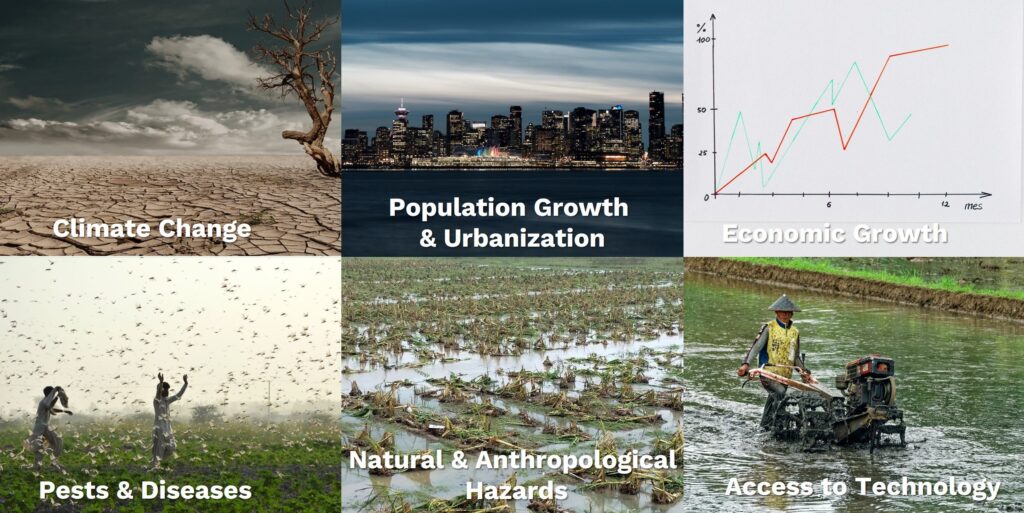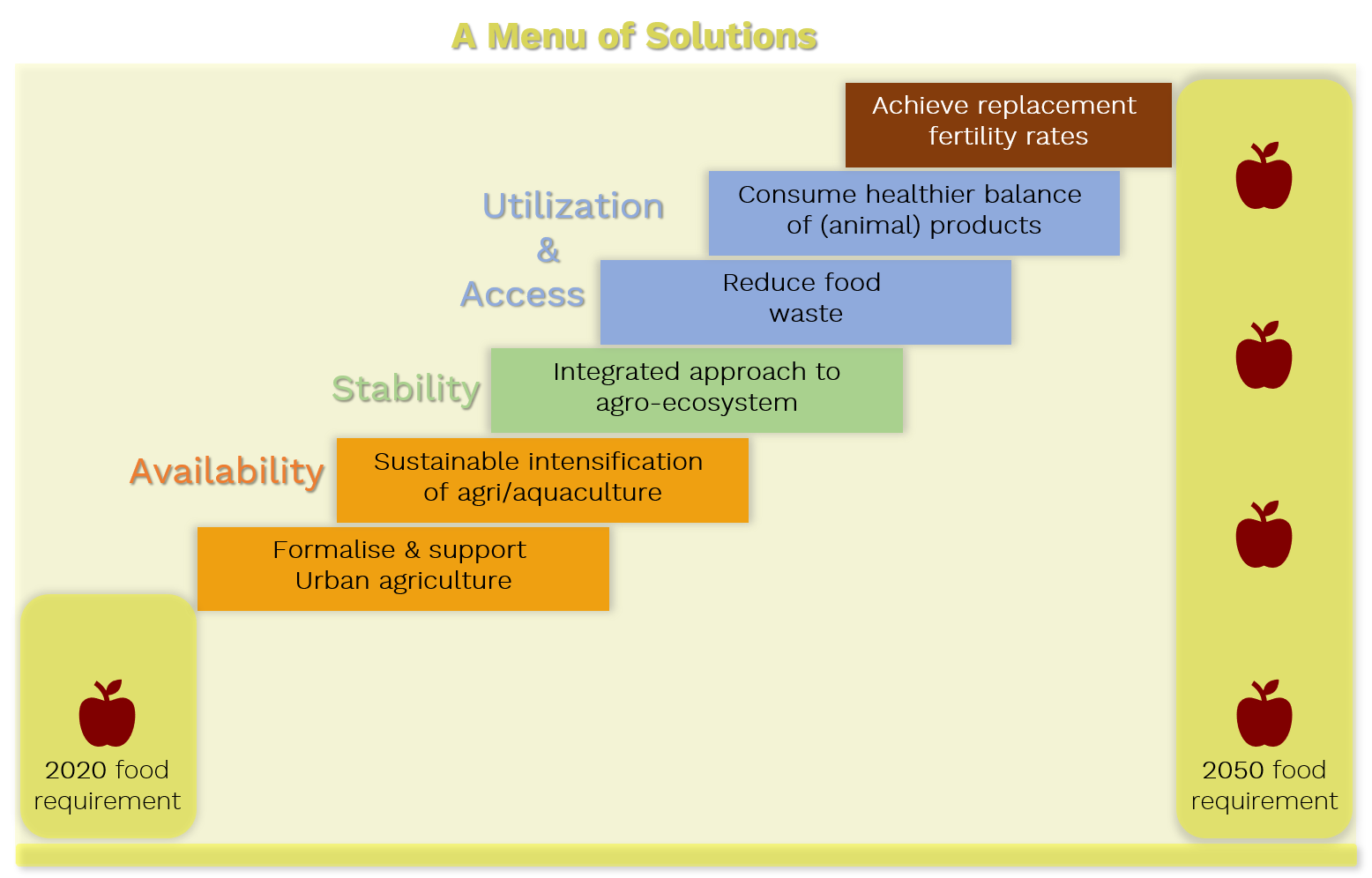Challenges to future food security
How to feed 10 billion people in 2050?
What challenges are there for food security?
- Instability in food production due to climate shocks, crop diseases, pests, and hazards [stability].
- Increased demand for affordable food and infrastructure due to rapid urbanization in Africa & Asia [availability & access]
- Economic growth yielding increased demand for meat and dairy products [availability]
- Inequalities in accessing technologies of food systems [availability & access].
- Increased consumption of highly processed and poor micro-nutrient food [utilization]

The food gap
The food gap is the difference between the crop calories produced in 2010 and those that the world will likely require in 2050 based on projected demand (WRI 2019). This gap can be closed both through measures that decrease the rate of growth in demand and measures that increase supply. The more the gap can be closed through demand-reduction measures, the smaller will be the challenge of increasing food production. And as that challenge decreases, so does the risk that the world will fail to meet food needs, which would most harshly affect the poor. Increased population and trends in consumption patterns mean that by 2050 we will need to produce 70 % more calories than we do now.
Can the world adequately feed nearly 10 billion people by the year 2050 in ways that help combat poverty, allow the world to meet climate goals, and reduce pressures on the broader environment?
How can we face the challenges to food security?
Learn about food production and food consumption side approaches to closing the food gap and about their respective challenges in the video below.
The figure below shows average yield gaps for major cereal crops. These were measured as a percentage of the attainable yield achieved in the year 2000 (Mueller et al., 2012). The biggest gaps between actual and attainable production are in developing countries.

Explore below the yield gap map of wheat. Customize the map to see the distribution of average yield gaps for different agricultural products.
A menu of solutions
How can we close the gap? We need solutions to these challenges:
- increase food production on existing land/water
- reduce the environmental impacts of food production
- promote a better balance of food that we consume have benefits for social and economic development in urban and rural settings
No single strategy can fulfill all these requirements. Instead, a menu of solutions targeting both food demand and food production in a sustainable way could be considered.
On the demand side:
- reducing food loss (on-farm, during storage and transportation) and waste (retailers and end consumers)
- shifting to healthier and more sustainable diets
- avoiding to use of land and edible foods for bioenergy production
On the production side:
- increase food production without expanding agricultural land
- Improving soil and water management
- adapting to climate change is important to increase the production
- protecting and restoring natural ecosystems
- limiting agricultural land-shifting
- reducing the emissions from agricultural production
The next plot provides an overview of how much cropland has been saved worldwide as a result of the increase in crop yields. Cropland continues to spread but is slowed down by that increase. Land sparing as a result of increased crop yields between 1961 and 2019.
There is no single solution to achieve food security. But food security challenges can be addressed by a number of different solutions, a „menu“ of solutions, an example of which is displayed in the figure below. Its implementation requires integrated actions and planning. To achieve this, we need spatial and temporal information and knowledge. These can be provided by EO data and tools.

Credit
This topic is created with the help of learning materials kindly provided by Prof. Dr. Andrew Nelson, International Institute for Geo-Information Science and Earth Observation (ITC), University of Twente.
Sources and further readings
Sources
JRC. (n.d.). Increasing Production. JRC World Atlas of Desertification. https://wad.jrc.ec.europa.eu/yieldsgaps.
Mueller, N. D., Gerber, J. S., Johnston, M., Ray, D. K., Ramankutty, N., & Foley, J. A. (2012). Closing yield gaps through nutrient and water management. Nature, 490(7419), 254–257. https://doi.org/10.1038/nature11420
Our World in Data. (2019). How much cropland has the world spared due to increases in crop yields? Our World in Data. https://ourworldindata.org/grapher/land-sparing-bycrop?country=Cereals~Fruit~Pulses~Sugar+Crops~Roots+Tubers~Vegetables~All+crops.
Ritchie, H., & Roser, M. (2021). Crop Yields. Our World in Data. https://ourworldindata.org/crop-yields
Searchinger, T., Waite, R., Hanson, C., Ranganathan, J., & Dumas, P. (2019). World Resources Report: Creating a Sustainable Food Future. A menu of solutions to feed nearly 10 billion people by 2050 (p. 564). World Resources Institute.
Further reading
Ittersum, M. K., van Bussel, L. G. J., Wolf, J., Grassini, P., van Wart, J., Guilpart, N., Claessens, L., de Groot, H., Wiebe, K., Mason-D’Croz, D., Yang, H., Boogaard, H., van Oort, P. A. J., van Loon, M. P., Saito, K., Adimo, O., Adjei-Nsiah, S., Agali, A., Bala, A., Cassman, K. G. (2016). Can sub-Saharan Africa feed itself? Proceedings of the National Academy of Sciences, 113(52), 14964–14969. https://doi.org/10.1073/pnas.1610359113
Mueller, N. D., Gerber, J. S., Johnston, M., Ray, D. K., Ramankutty, N., & Foley, J. A. (2012) article: Closing yield gaps through nutrient and water management https://doi.org/10.1038/nature11420.
Munesue, Y., Masui, T., & Fushima, T. (2015). The effects of reducing food losses and food waste on global food insecurity, natural resources, and greenhouse gas emissions. Environmental Economics and Policy Studies, 17(1), 43–77. https://doi.org/10.1007/s10018-014-0083-0
Our World in Data (2019) website: How much cropland has the world spared due to increases in crop yields https://ourworldindata.org/grapher/land-sparing-by-crop?country=Cereals~Fruit~Pulses~Sugar+Crops~Roots+and+Tubers~Vegetables~All+crops.
Searchinger, T., Waite, R., Hanson, C., Ranganathan, J., Dumas, P., 2019. World Resources Report: Creating a Sustainable Food Future. A menu of solutions to feed nearly 10 billion people by 2050. World Resources Institute.
You covered the challenges of achieving global food security and how to face these challenges.
Next, let’s take a look at how EO can be utilized for food security.
Complete the quiz below to advance to the next topic!
Discussion
-
Challenges to future food security
Sorry, there were no replies found.
Log in to reply.


